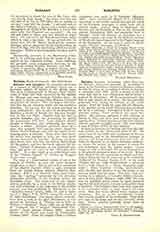

Barlaam and Josaphat, the principal characters of a legend of Christian antiquity, which was a favorite subject of writers in the Middle Ages. The story is substantially as follows: Many inhabitants of India had been converted by the Apostle St. Thomas and were leading Christian lives. In the third or fourth century King Abenner (Avenier) persecuted the Church. The astrologers had foretold that his son Josap hat would one day become a Christian. To prevent this the prince was kept in close confinement. But, in spite of all precautions, Barlaam, a hermit of Senaar, met him and brought him to the true Faith. Abenner tried his best to pervert Josaphat, but, not succeeding, he shared the government with him. Later Abenner himself became a Christian, and, abdicating the throne, became a hermit. Josaphat governed alone for a time, then resigned, went into the desert, found his former teacher Barlaam, and with him spent his remaining years in holiness. Years after their death, the bodies were brought to India and their grave became renowned by miracles. Barlaam and Josaphat found their way into the Roman Martyrology (November 27), and into the Greek calendar (August 26). Vincent of Beauvais, in the thirteenth century, had given the story in his “Speculum Historiale”. It is also found in an abbreviated form in the “Golden Legend” of Jacobus de Voragine of the same century.
The story is a Christianized version of one of the legends of Buddha, as even the name Josaphat would seem to show. This is said to be a corruption of the original Joasaph, which is again corrupted from the middle Persian Budsif (Budsaif = Bodhisattva). Still it is of historical value, since it contains the “Apology” presented by the Athenian philosopher Aristides to the Emperor Adrian (or Antoninus Pius). The Greek text of the legend, written probably by a monk of the Sabbas monastery near Jerusalem at the beginning of the seventh century, was first published by Boissonade in his “Anecdota Graeca” (Paris, 1832), IV, and is reproduced in Migne, P.G., XCVI, among the works of St. John Damascene. The legend cannot, however, have been a work of the great Damascene, as was proved by Zotenberg in “Notices sur le livre de Barlaam et Josaphat” (Paris, 1886) and by Hammel in “Verhandl des 7 internat. Orientalisten Congresses”, Semit. Section (Vienna, 1888). Another edition of the Greek was made by Kechajoglos (Athens, 1884). From the original Greek a German translation was made by F. Liebrecht (Munster, 1847). Latin translations (Migne, P.L., LXXIII), were made in the twelfth century and used for nearly all the European languages, in prose, verse and in miracle plays. Among them is prominent the German epic by Rudolph of Ems in the thirteenth century (Konigsberg, 1818, and somewhat later at Leipzig). From the German an Icelandic and a Swedish version were made in the fifteenth century. At Manila the legend appeared in the Tagala language of the Philippines. In the East it exists in Syriac, Arabic, Ethiopic, Armenian, and Hebrew.
FRANCIS MERSHMAN

